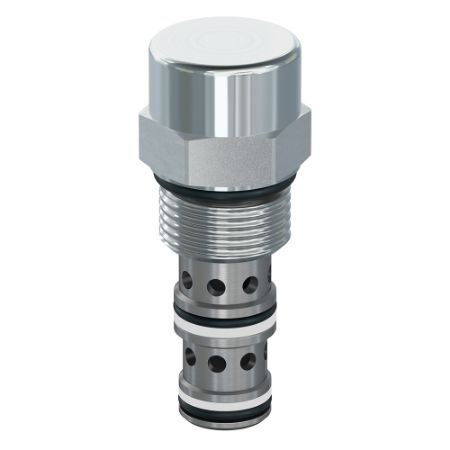- Availability & Price
- Search SKU
Filter by attributes
- Actuation Type
- Adjustment Mechanism
- Body Material
- Cavity Size
- Configuration
- Connection Size
- Connection Type
- Division
- Division
- Filter Efficiency Rating
Pressure Compensators/Control Elements

*PRODUCT IMAGE IS REPRESENTATIVE PROVIDED BY THE MANUFACTURER. DO NOT MAKE BUYING DECISIONS SOLEY BASED ON THE IMAGE. PLEASE VERIFY SPECIFICATIONS MEET YOUR REQUIREMENTS.
Parker’s family of pressure compensator valves feature a robust and contamination tolerant design that ensures consistent flow regardless of up or down stream pressures. These valves can operate with hydraulic system flows as high as 150 lpm and pressures up to 245 bar with a variety of differential pressure setting options. Parker’s pressure compensator valves are ideal for constant and consistent flow applications such as conveyors or saws within mobile, industrial, or manufacturing markets.
Markets:
• Miscellaneous Industrial
• Miscellaneous Manufacturing
• Miscellaneous Mobile
Features/Benefits:
• Stable and quiet response
• Contamination tolerant
• Hardened working parts for maximum durability
• All external parts zinc plated
Applications:
• Conveyors
• Saws
• Constant and consistent flow applications
Additional Technical Insight:
Inlet flow (upstream of the orifice or flow control valve) is split with one portion going to the compensator port inlet, the other portion passes through the orifice, or flow control valve, to the supply port. As pressure drop across the orifice reaches the selected compensator pressure drop, the higher pressure (pre-orifice) starts to shift the compensator spool into a throttling position. The valve works to maintain a constant pressure drop across the orifice. Using this type of valve allows greater flexibility in design and flows as these valves can flow as much as 40 gallons per minute. Compensator valves are used in circuits where a constant flow is desired regardless of upstream or downstream loads. As the pressure downstream of the compensator increases, the valve is forced open to maintain the constant pressure drop across the fixed, or adjustable, orifice. Conversely, if the pressure increases upstream of the orifice, the compensator valve will be forced closed to maintain the constant pressure drop across the orifice.
Read More...Markets:
• Miscellaneous Industrial
• Miscellaneous Manufacturing
• Miscellaneous Mobile
Features/Benefits:
• Stable and quiet response
• Contamination tolerant
• Hardened working parts for maximum durability
• All external parts zinc plated
Applications:
• Conveyors
• Saws
• Constant and consistent flow applications
Additional Technical Insight:
Inlet flow (upstream of the orifice or flow control valve) is split with one portion going to the compensator port inlet, the other portion passes through the orifice, or flow control valve, to the supply port. As pressure drop across the orifice reaches the selected compensator pressure drop, the higher pressure (pre-orifice) starts to shift the compensator spool into a throttling position. The valve works to maintain a constant pressure drop across the orifice. Using this type of valve allows greater flexibility in design and flows as these valves can flow as much as 40 gallons per minute. Compensator valves are used in circuits where a constant flow is desired regardless of upstream or downstream loads. As the pressure downstream of the compensator increases, the valve is forced open to maintain the constant pressure drop across the fixed, or adjustable, orifice. Conversely, if the pressure increases upstream of the orifice, the compensator valve will be forced closed to maintain the constant pressure drop across the orifice.
| Action | SKU | Availability | Partner Available | Price | Flow Rate Accuracy | Cavity Size | Maximum Operating Temperature | Maximum Operating Pressure | Operation Type | Division | Maximum Flow Rate | Maximum Kinematic Viscosity | Configuration | Adjustment Mechanism | Seal Material | Installation Torque | Filter Efficiency Rating | Flow Rate | Operating Temperature | Connection Type | Connection Size | Division | Weight | Function | Maximum Inlet Pressure Rating | For Fluid Type | Body Material | Pressure Differential | Valve Material | Actuation Type | Minimum Operating Temperature | Seal Material | Maximum Flow Rate | Pressure Differential |
|---|---|---|---|---|---|---|---|---|---|---|---|---|---|---|---|---|---|---|---|---|---|---|---|---|---|---|---|---|---|---|---|---|---|---|
| FCR161F04 | Backordered | 10% | C16-3 | 245 bar | 3500 psi | Pressure sensing | Hydraulic Cartridge Systems Division | 40 Gal/min | 45-2000 SSU (6 to 420 cSt) | Used with external orifice (fixed or variable) | Fixed | Nitrile | 40 lb-ft | ISO 4406 18/16/13, SAE Class 4 | 40 Gal/min | -34 to +121 °C | n/a | n/a | Hydraulic Systems Division | 0.75 lb | Pressure Compensating Valve | 3500 psi | Mineral-based or synthetic hydraulic fluids | n/a | 2.8 bar | All parts steel. All operating parts hardened steel | Restrictive type | +250 °F | Nitrile | 40 GAL/MIN, 150 L/MIN | 40 PSI, 2.8 BAR |


